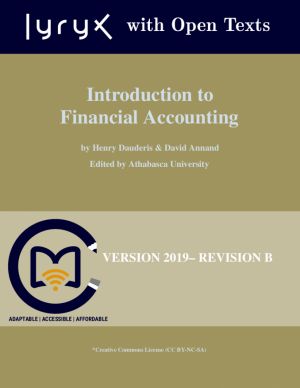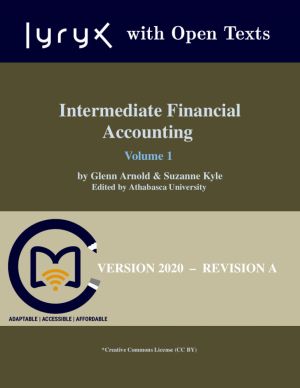Introduction to Financial Accounting: U.S. GAAP Adaptation
by Henry Dauderis, David Annand, Donna L. Marchand
DescriptionTable of ContentsDetailsHashtagsReport an issue
Donna L. Marchand, CPA, is an Assistant Professor of Accounting at Emmanuel College in Boston. Prior to taking this position she worked as a full-time instructor at Wheaton College in Norton, MA, and played a key role in transitioning the Business and Management program into a fully open source program for students. Prior to this, she worked as Director of the Academic Achievement Center and full-time instructor at Bridgewater State University in Bridgewater, MA. Before transitioning into higher education she worked in public accounting. However, her career initially began in K-12 education, playing an integral role in launching a fully inclusive education program that became a state-wide model in New York State. 






Book Description
Introduction to Financial Accounting: U.S. GAAP, was intended for a first course in introductory financial accounting. It focuses on core introductory financial accounting topics that match pre-requisite requirements for students advancing to intermediate financial accounting. A corporate approach is utilized versus beginning with a sole proprietorship emphasis and then converting to a corporate approach; this consistency throughout the book reduces confusion for the introductory student. This most recent revision by D. Marchand converted the text from IFRS to reflect the Generally Accepted Accounting Principles of the United States (U.S. GAAP).Donna L. Marchand, CPA, is an Assistant Professor of Accounting at Emmanuel College in Boston. Prior to taking this position she worked as a full-time instructor at Wheaton College in Norton, MA, and played a key role in transitioning the Business and Management program into a fully open source program for students. Prior to this, she worked as Director of the Academic Achievement Center and full-time instructor at Bridgewater State University in Bridgewater, MA. Before transitioning into higher education she worked in public accounting. However, her career initially began in K-12 education, playing an integral role in launching a fully inclusive education program that became a state-wide model in New York State.
This open book is licensed under a Creative Commons License (CC BY-NC-SA). You can download Introduction to Financial Accounting: U.S. GAAP Adaptation ebook for free in PDF format (3.3 MB).
Table of Contents
Chapter 1
Introduction to Financial Accounting
Chapter 2
The Accounting Process
Chapter 3
Financial Accounting and Adjusting Entries
Chapter 4
The Classified Balance Sheet and Related Disclosures
Chapter 5
Accounting for the Sale of Goods
Chapter 6
Assigning Costs to Merchandise
Chapter 7
Cash and Receivables
Chapter 8
Long-lived Assets
Chapter 9
Debt Financing: Current and Long-term Liabilities
Chapter 10
Equity Financing
Chapter 11
The Statement of Cash Flows
Chapter 12
Financial Statement Analysis
Chapter 13
Proprietorships and Partnerships
Solutions To Discussion Questions
Solutions To Exercises
Solutions To Problems
Book Details
Title
Introduction to Financial Accounting: U.S. GAAP Adaptation
Subject
Economics and Finance
Publisher
Lyryx
Published
2019
Pages
787
Edition
1
Language
English
PDF Size
3.3 MB
License

Related Books

Introduction to Financial Accounting is intended for a first course in introductory financial accounting. It has been extensively edited by Athabasca University and reflects current International Financial Reporting Standards (IFRS). A corporate approach is utilized versus beginning with a sole proprietorship emphasis and then converting to a corpo...

Introduction to Financial Mathematics: Concepts and Computational Methods serves as a primer in financial mathematics with a focus on conceptual understanding of models and problem solving. It includes the mathematical background needed for risk management, such as probability theory, optimization, and the like. The goal of the book is to expose th...

This book is intended for an undergraduate or MBA level Financial Accounting course. It covers the standard topics in a standard sequence, utilizing the Socratic method of asking and answering questions....

Intermediate Financial Accounting Volume 1 developed in collaboration by Athabasca University and Lyryx, is intended for a first course in Intermediate Financial Accounting, and presumes that students have already completed one or two Introductory Financial Accounting courses. The textbook reflects current International Financial Reporting Standard...

This workbook was designed for the Introduction to Archaeology (ANTH 2339) class in the Department of Sociology and Anthropology, University of Texas at Arlington. It was created to provide exercises that supplement and expand on topics and issues raised in lecture. For each major topic, students complete exercises that serve a range of functions; ...

Freshly updated for GTK3, the 2nd edition of An Introduction to C & GUI Programming will teach you all you need to know to write simple programs in C and start creating GUIs, even if you're an absolute beginner.
The first half of the book is an introduction to C, and covers the basics of writing simple command-line programs. The second ...

